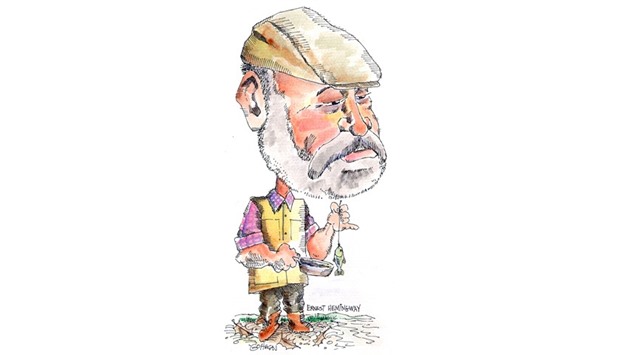Ernest Hemingway, one of the greatest American novelists, had an important relationship with many Latin American writers, whom he inspired. In none, however, he left such as a strong impression as in Gabriel Garcia Marquez.
Marquez was walking down the Boulevard Saint Michel in Paris, a rainy spring of 1957 when he saw, on the opposite side, the unmistakable figure of Hemingway. For a brief moment, Marquez didn’t know whether to ask him for an interview or cross the avenue to express his admiration. In one of his articles, Marquez recounts this moment:
“I recognised him immediately, as he passed with his wife Mary Welsh on the Boulevard St Michel in Paris one rainy spring day in 1957. He walked on the other side of the street, toward the Luxembourg Gardens, wearing a worn pair of cowboy pants, a plaid shirt and a ballplayer’s cap. The only thing that didn’t look as if it belonged to him was a pair of metal-rimmed glasses, tiny and round, which gave him a premature grandfatherly air.
“For a fraction of a second, as always seemed to be the case, I found myself divided between my two competing roles. I didn’t know whether to ask him for an interview or cross the avenue to express my unqualified admiration for him. But with either proposition, I faced the same great inconvenience. I spoke the same rudimentary English I speak to this day, and I wasn’t very sure about his bullfighter’s Spanish.
“And so I didn’t do either of the things that could have spoiled that moment, but instead cupped both hands over my mouth and, like Tarzan in the jungle, yelled from one sidewalk to the other: ‘Maeeestro!’ Ernest Hemingway understood that there could be no other master amid the multitude of students, and he turned, raised his hand and shouted to me in Castilian in a very childish voice, ‘Adioo?s, amigo!’ It was the only time I saw him.”
Marquez thus expressed his appreciation for one of the two authors who most influenced his work (the other was William Faulkner). Cuba, where Hemingway lived for several years, had a big influence on Hemingway’s life. His first trip to the island was in April of 1934, together with his second wife, Pauline Pfeiffer. However, it was his third wife, Martha Gellhorn, who chose their home in Finca Vigia, located on a small hill of San Francisco de Paula, a few kilometres away from Havana.
In Cuba, Hemingway wrote Across the River and Into the Trees, A Moveable Feast, Gulf Islands and Cuba’s iconic novel The Old Man and the Sea.
With The Old Man and the Sea, Hemingway said he found the literary tone he had sought all his life. That book won him the Pulitzer Prize and catapulted him to the Nobel Prize. In the words of the prize committee, he received it for his “mastery of the art of storytelling, which was recently demonstrated in The Old Man and the Sea, and the influence it has exerted on contemporary style”, which consisted of simple sentences and simple syntax, almost telegraphic in its expression. Hemingway called his style the “iceberg theory” where the facts float on water and the support structure and symbolism operate out of sight.
In addition to Finca Vigia, Hemingway’s preferred places in Cuba were the room in the Hotel Ambos Mundos, where he sometimes secluded himself to write, his frequently visited bar Floridita and the restaurant Bodeguita del Medio. The latter was a favourite as well of Errol Flynn, Gabriela Mistral, Salvador Allende, Marquez, Pablo Neruda, and many other personalities.
In a famous interview with the writer George Plimpton for The Paris Review Hemingway said: “Once writing has become the main vice and the greatest pleasure, only death can end it.”
Maybe he thought about that when, following what appeared to be a tragic family tradition (his father Clarence, his sister Ursula and his brother Leicester committed suicide before him) he ended his life in Ketchum, Idaho, with his favourite shotgun, on the morning of July 2, 1961.
- Dr Cesar Chelala is a New York writer and a winner of an Overseas Press Club of America award and two journalism awards from Argentina.

